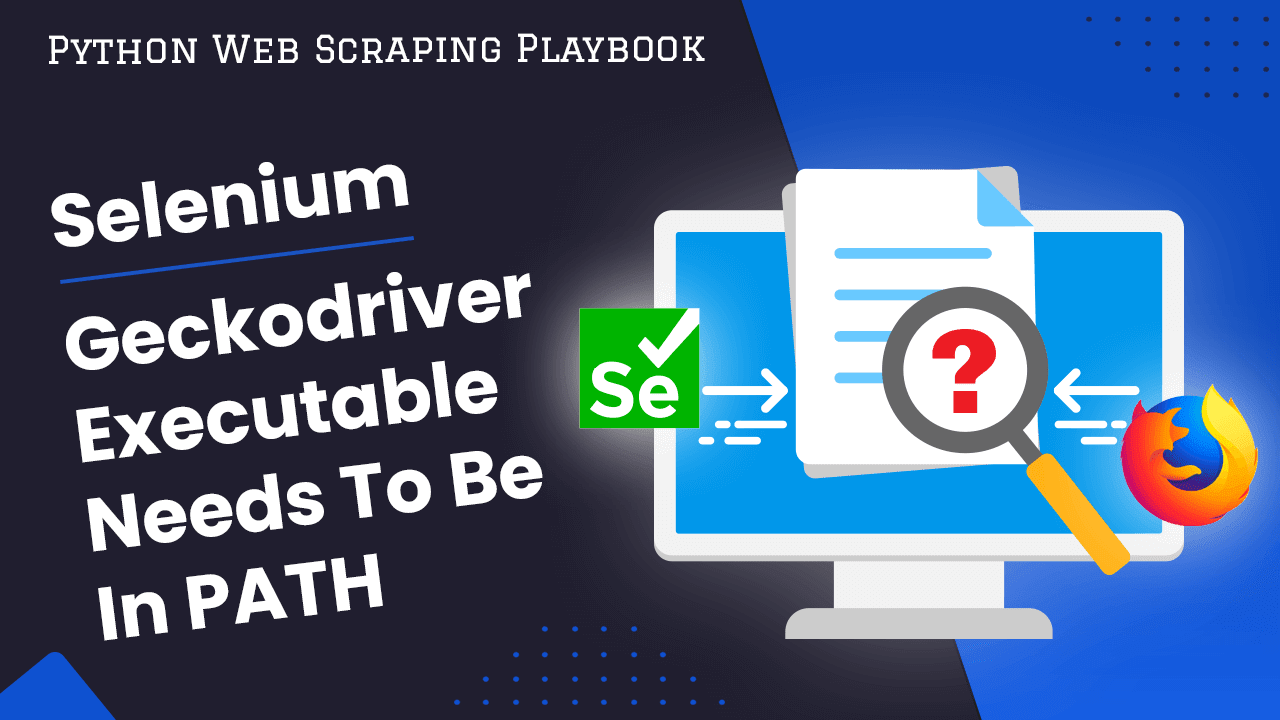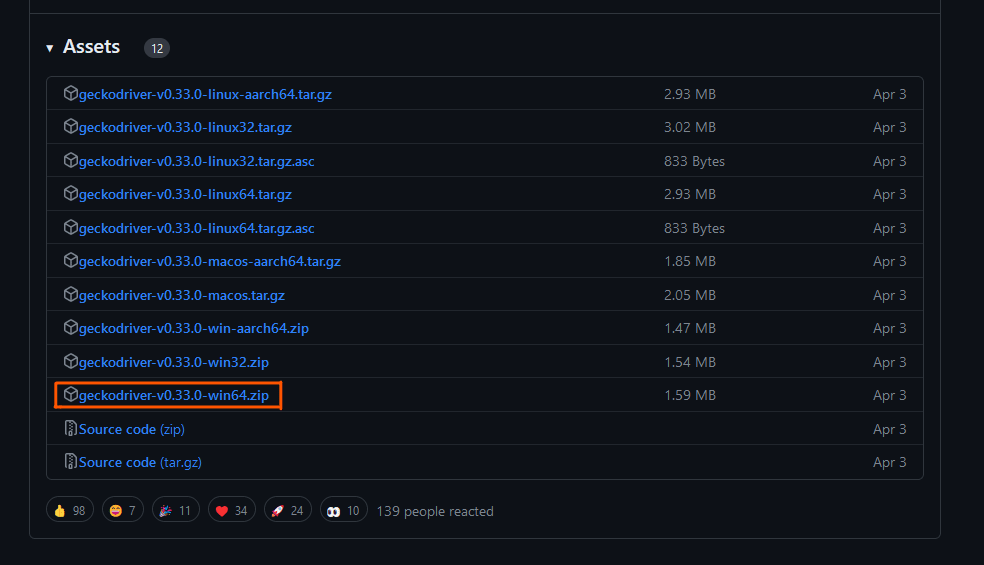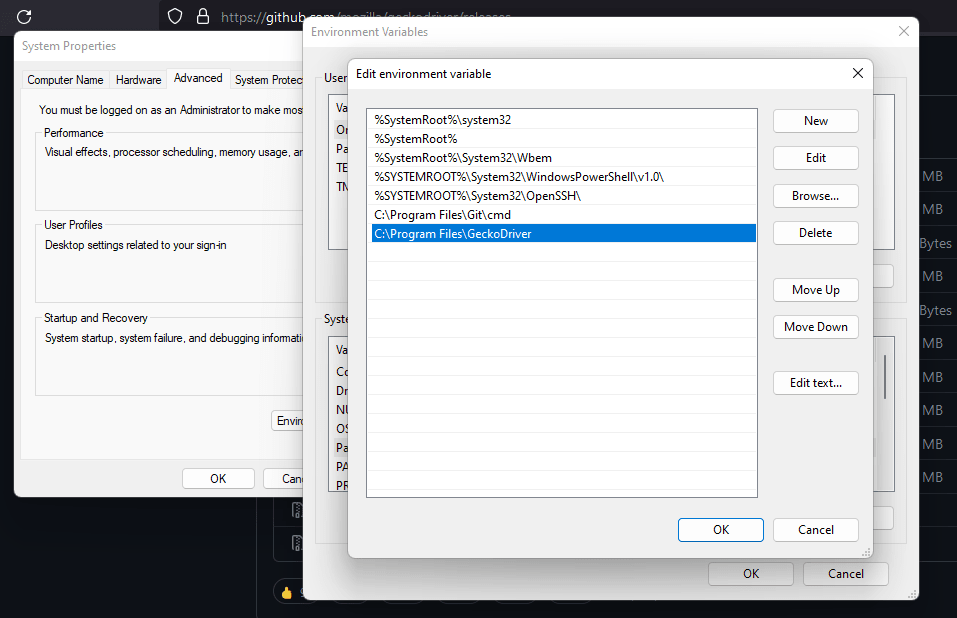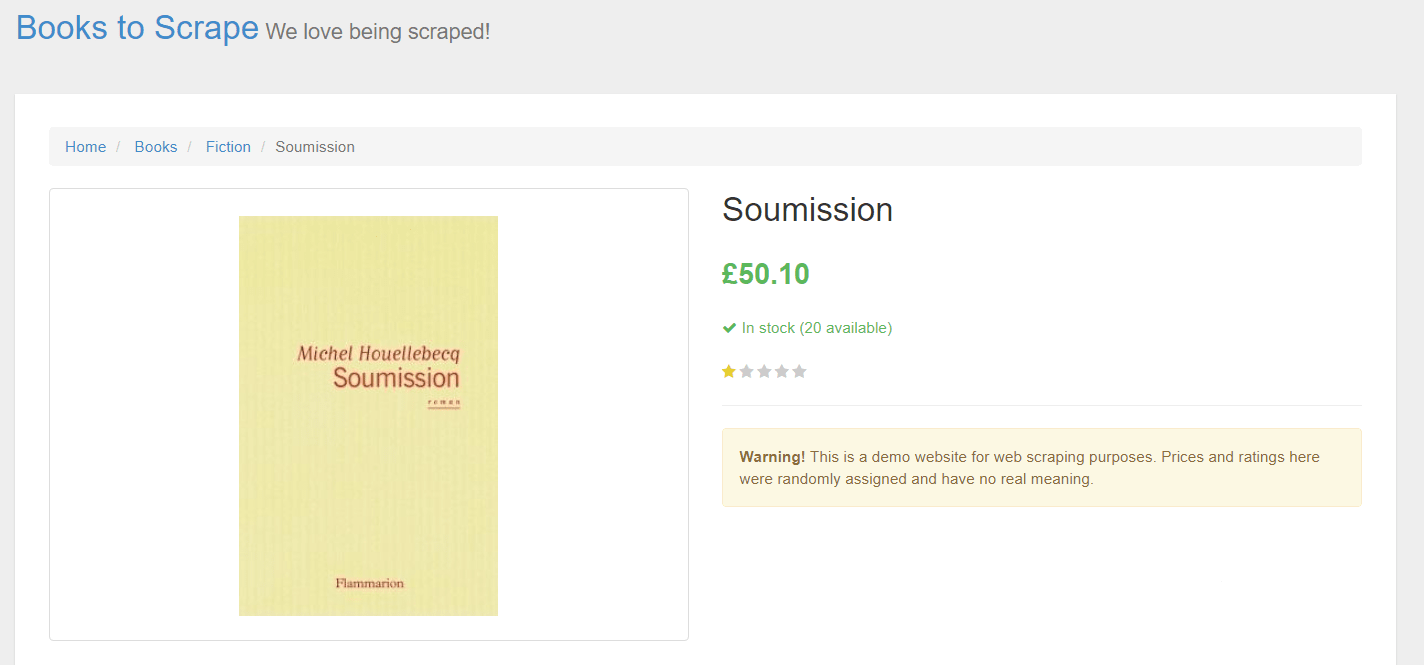
Selenium Error: Geckodriver Executable Needs to Be in PATH
Selenium is a powerful tool for automating web browsers and is widely used for testing and web scraping. However, you may encounter a common error message: "Selenium Error: Geckodriver Executable Needs To Be In PATH."
In this article, we'll delve into the causes of this error and explore effective solutions to resolve it.
- What Is Geckodriver?
- Why Geckodriver Needs to Be in the System's PATH
- Resolving the Geckodriver Executable Needs to Be in PATH Error
- Common Causes Of The Geckodriver Executable Needs To Be In PATH Error
- Troubleshooting Tips
- Conclusion
- More Web Scraping Guides
Need help scraping the web?
Then check out ScrapeOps, the complete toolkit for web scraping.
What Is Geckodriver?
Geckodriver serves as a middleman between Selenium and Firefox. It acts as a proxy that communicates using the same language as Selenium (W3C WebDriver protocol), facilitating their interaction. Without Geckodriver, Selenium cannot communicate with Firefox.
Why Geckodriver Needs to Be in the System's PATH
Think of PATH as a map that guides your computer to find essential components. Geckodriver needs to be on that map (in the PATH) so that when Selenium asks, 'Hey, where's Geckodriver?' your computer can quickly point the way. It's akin to having the right address for a seamless conversation between Selenium and Firefox.
Here are the main reasons why Geckodriver should be in the system's PATH:
-
Accessibility: Placing Geckodriver in the system's PATH makes it accessible from any directory on the system. This ensures that Selenium or other tools can locate and use Geckodriver without needing to know its specific location.
-
Ease of Use: Including Geckodriver in the PATH simplifies the setup and configuration process. Users don't have to provide the full path to Geckodriver every time they run a Selenium script; they can simply call the executable by its name.
-
Automation Scripts: Selenium scripts or any other automation tools that rely on Geckodriver can seamlessly locate and launch it when needed. This ease of integration simplifies the deployment of automation scripts across different environments.
Resolving the Geckodriver Executable Needs to Be in PATH Error
So, when you encounter the 'Selenium Error: Geckodriver Executable Needs To Be In PATH,' don't sweat it! Two common fixes can save the day:
- Adding Geckodriver to the PATH: It's like giving directions to your computer so it can find Geckodriver when Selenium needs it.
- Using The
webdriver_managerPackage: This one's like having a magical helper that fetches Geckodriver for you, so no manual setup fuss!
If you're eager to dive into a step-by-step demo to sort this out, hop on over to the next section! We'll guide you through it—no tech jargon, just easy steps to get things rolling smoothly.
Method 1: Adding Geckodriver to the PATH
Before Adding Geckodriver to the PATH, ensure that you are using a compatible version of Geckodriver with your Selenium and Firefox versions. After that, you can add Geckodriver to the PATH using the following steps:
- Step 1: Download Geckodriver
Visit the official Geckodriver GitHub repository. Scroll to the Assets section and download the latest release for your machine: Geckodriver Releases.
For example, I am downloading Geckdriver for a Windows 64-based machine.

- Step 2: Add the Geckodriver to the PATH.
Let us add the downloaded Geckodriver to the PATH.
For Windows:
Right-click to extract the downloaded zip file to your preferred destination.

First, I am creating a folder in the C:\Program Files\GeckoDriver and extracting it there. The next step is to locate the PATH before adding the Geckodriver executable to it.
By pressing the Windows key, search for Edit the system environment variables settings.

Under the Advanced menu, click on Environment Variables

Under System variables, select Path then click on the Edit... button.

I have added the Geckodriver executable to a destination that exists in the PATH.

If your Geckodriver destination does not exist in the PATH, return to the directory and copy the full path to the directory containing the Geckodriver executable.

Return to the system variables Path settings and add a New destination.

Click OK until all the prompts are closed.
Linux/macOS
We will use Ubuntu 22.04 for this demo.
Download and extract the Geckodriver file to your preferred destination. I have downloaded the driver and extracted it in the Downloads folder.

Make the file executable.
chmod +x geckodriver
Then, add the executable file to PATH.
export PATH=$PATH:/path-to-extracted-file/.
- Step 3: Verify Installation
Open a command prompt or terminal. Run geckodriver --version to verify that Geckodriver is installed and correctly added to PATH.
Windows

Linux

I have installed Geckodriver version 0.33.0 on Windows 10 and Ubuntu 22.04.
- Step 4: Restart Your Development Environment
After making these changes, restart your command prompt, IDE, or terminal session to ensure the updated PATH is recognized.
If these steps don't work then:
Update Your Selenium Script
If you continue to face issues, explicitly specify the path to Geckodriver in your Selenium script. For example, in Python:
from selenium import webdriver
driver = webdriver.Firefox(executable_path='/path/to/geckodriver')
Replace the /path/to/geckodriver with the path to your Geckodriver.
from selenium import webdriver
from selenium.webdriver.firefox.options import Options
# Specify the path to the GeckoDriver executable
geckodriver_path = 'C:/Program Files/GeckoDriver/geckodriver.exe'
# Create a FirefoxOptions object
options = Options()
# Set the binary location to the path of the GeckoDriver executable
options.binary_location = geckodriver_path
# Initialize the WebDriver with the FirefoxOptions object
driver = webdriver.Firefox(options=options)
# Open the specified URL
driver.get('https://books.toscrape.com/')
# Perform your scraping or automation tasks here...
# Quit the WebDriver when done
driver.quit()
For example, I have specified the path to the driver as C:/Program Files/GeckoDriver/geckodriver.exe
Check Firefox Version Ensure that the version of Firefox installed on your system is compatible with the Geckodriver version you downloaded. Launch the Firefox browser. On the topmost right corner, click on button with three lines followed by Help and About Firefox. The Firefox browser's version is displayed.
Check whether the Firefox version is compatible with the Geckodriver version. For instance, my Firefox version 120 matches the required minimum of 102 for 0.33.0 version of the Geckodriver I installed on the machine.

By following these steps, you should be able to resolve the "Geckodriver executable needs to be in PATH" error in Selenium.
Method 2: Using The webdriver_manager Package
If you're encountering the "Geckodriver executable needs to be in PATH" error and you're using the webdriver-manager package in Python, fixing the issue becomes simpler. The webdriver-manager automatically downloads the driver binaries (like Geckodriver for Firefox) and sets the path, which reduces the manual configuration.
- Using pip or anaconda, install
webdriver-manager.
pip install selenium webdriver-manager
The above command installs selenium and the webdriver-manager which we can use to access Firefox as follows:
- Use the webdriver-manager package to obtain the appropriate driver for Firefox.
from selenium import webdriver
from selenium.webdriver.firefox.service import Service as FirefoxService
from webdriver_manager.firefox import GeckoDriverManager
# Use webdriver_manager to install and manage the GeckoDriver executable
driver = webdriver.Firefox(service=FirefoxService(GeckoDriverManager().install()))
Let's break down each line of the provided code:
from selenium import webdriver: Import thewebdrivermodule from the Selenium package. Thewebdrivermodule provides an API for interacting with web browsers.from selenium.webdriver.firefox.service import Service as FirefoxService: Import theServiceclass from theselenium.webdriver.firefox.servicemodule. This class represents the service that will be used to start the Firefox browser. It is aliased asFirefoxServicefor convenience.from webdriver_manager.firefox import GeckoDriverManager: Import theGeckoDriverManagerclass from thewebdriver_manager.firefoxmodule. This class is responsible for managing the installation and configuration of the GeckoDriver executable, which is required for controlling the Firefox browser.driver = webdriver.Firefox(service=FirefoxService(GeckoDriverManager().install())): This line does the following:GeckoDriverManager().install(): Calls theinstallmethod of theGeckoDriverManagerclass, which automatically downloads and installs the appropriate version of GeckoDriver. This is a convenient way to manage the WebDriver executable without manual downloads.FirefoxService(...): Creates an instance of theFirefoxServiceclass, representing the service used to start the Firefox browser. It takes the path to the GeckoDriver executable as an argument.webdriver.Firefox(service=...): Initializes a Firefox WebDriver using the specified service (including the GeckoDriver executable). Thedrivervariable now holds an instance of the Firefox WebDriver that you can use to automate interactions with a web page.
-
Full code example
Here is a full code example where we use the webriver-manager and Geckodriver to scrape book details from the BooksToScrape page.
# Import necessary modules
from selenium import webdriver
from selenium.webdriver.firefox.service import Service as FirefoxService
from webdriver_manager.firefox import GeckoDriverManager
from selenium.webdriver.common.by import By
# Set up the WebDriver with GeckoDriver using webdriver_manager
driver = webdriver.Firefox(service=FirefoxService(GeckoDriverManager().install()))
# Navigate to the specified URL
driver.get('https://books.toscrape.com/catalogue/soumission_998/index.html')
# Find the element representing book details on the page
details = driver.find_element(By.CLASS_NAME, 'product_page')
# Extract and print the book price
price = details.find_element(By.CLASS_NAME, 'price_color').text
print(f"Book Price: {price}")
# Extract and print the cover image URL of the book
cover_image = details.find_element(By.TAG_NAME, 'img').get_attribute('src')
print(f"Cover Image URL: {cover_image}")
# Close the WebDriver (optional, but recommended to free up resources)
driver.quit()


Common Causes Of The Geckodriver Executable Needs To Be In PATH Error
Identification of common scenarios leading to the "Geckodriver Executable Needs To Be In PATH" error is crucial for resolving issues related to Selenium WebDriver's interaction with the Firefox browser.
This error often arises from various factors, and understanding these causes is essential for effective troubleshooting.
Some of the causes include:
Geckodriver Not Installed
Selenium requires Geckodriver to interact with the Firefox browser, and if it's not installed, the error will be triggered. This emphasizes the prerequisite of having Geckodriver installed on the system where Selenium scripts are executed. Proper installation ensures that Selenium can locate and utilize Geckodriver during browser automation tasks.
Incorrect Geckodriver Version
Mismatched versions between Selenium, Geckodriver, and Firefox can lead to compatibility issues, triggering the "Geckodriver Executable Needs To Be In PATH" error. This highlights the importance of maintaining version compatibility among these components to ensure smooth execution of Selenium scripts.
Geckodriver Not in the System's PATH
If Geckodriver is not correctly added to the system's PATH (environment variable), Selenium won't be able to locate and use it, resulting in the error message. Proper configuration of the system's PATH is vital for Selenium to identify the Geckodriver executable, allowing for successful communication between Selenium and the Firefox browser.
Incorrect Geckodriver Initialization
Improper initialization or configuration of Geckodriver within your Selenium script can also be a source of the error. It is essential to ensure the correct path and version are specified in your code. This emphasizes the need for meticulous attention to detail when integrating Geckodriver into Selenium scripts.
Permissions Issues
Insufficient permissions to access or execute the Geckodriver executable can result in the error. Ensure that the user running the Selenium script has the necessary permissions. Addressing permission-related issues is crucial to overcoming obstacles that may impede Geckodriver execution.
System Environment Variables Setup
On some systems, setting up environment variables might be necessary for Selenium to locate Geckodriver. Failure to configure these variables correctly can lead to the error. This underscores the importance of understanding and appropriately configuring system environment variables to facilitate proper communication between Selenium and Geckodriver.
Selenium WebDriver Configuration Issues
Incorrect configuration of the WebDriver in your Selenium script can also cause the error. Ensure that you are using the correct WebDriver and have configured it appropriately in your script. This highlights the need for alignment between the WebDriver settings in the script and the installed version of Geckodriver, emphasizing the importance of accurate configuration to prevent errors.
Troubleshooting Tips:
Facing persistent issues despite adding Geckodriver to the system's PATH can be frustrating.
Troubleshooting is an integral part of Selenium automation, and a systematic approach can help resolve issues efficiently. By following these troubleshooting tips, you can address common pitfalls and misconceptions related to Geckodriver configuration.
- Verify Geckodriver Installation:
- Double-check that Geckodriver is correctly installed on your system. Ensure that the version you've installed is compatible with both your Selenium version and Firefox browser.
- PATH Variable Configuration:
- Confirm that Geckodriver is added to the system's PATH variable. Sometimes, modifications to the PATH variable may require a system restart to take effect. Restart your terminal or command prompt after making changes.
- Check Geckodriver Version:
- Ensure that you are using the correct version of Geckodriver. Mismatched versions between Selenium, Geckodriver, and Firefox can lead to compatibility issues. Refer to the documentation to find the appropriate Geckodriver version for your setup.
- Use Full Path in Code:
- If adding Geckodriver to the system's PATH does not resolve the issue, consider specifying the full path to Geckodriver directly in your Selenium script. This ensures that your script can locate Geckodriver regardless of system configurations.
- Environment Variables in Virtual Environments:
- If you are using virtual environments, ensure that Geckodriver is added to the PATH of the virtual environment. Activating the virtual environment should automatically set up the correct PATH for the environment.
- Check Browser and Geckodriver Compatibility:
- Verify that the Geckodriver version is compatible with the Firefox browser version you are using. Firefox updates may require corresponding updates to Geckodriver to maintain compatibility.
- Permissions Issues:
- Address any permissions issues that might prevent the execution of Geckodriver. Ensure that the user running the Selenium script has the necessary permissions to access and execute the Geckodriver executable.
- Firewall and Antivirus Software:
- Check if firewall or antivirus software is blocking Geckodriver's execution. Temporarily disable these security features and see if the issue persists. If so, configure them to allow Geckodriver execution.
- Logging and Debugging:
- Enable logging and debugging in your Selenium script to get more detailed information about the issue. Logging can provide insights into what part of the script is failing and help pinpoint the root cause.
- Community Support and Forums:
- Seek help from the Selenium and Geckodriver communities. Forums, discussion groups, and online communities often have experienced users who can provide assistance and share insights into specific issues.
Best Practices for Geckodriver Management:
Suggestions for managing Geckodriver versions across different projects:
When working on multiple projects that involve Selenium automation with the Firefox browser, effective Geckodriver management becomes crucial for maintaining a consistent and hassle-free development environment. Here are some recommendations for managing Geckodriver versions across different projects:
- Use Virtual Environments:
- Consider using virtual environments for each project. Virtual environments provide project-specific isolation, allowing you to install and manage dependencies, including Geckodriver, separately for each project.
- Leverage Package Managers:
- Utilize package managers like
pipto install and manage Geckodriver within the virtual environment. This ensures that each project can specify its Geckodriver version independently, preventing conflicts between different projects.
- Utilize package managers like
- Requirements.txt File:
- Maintain a
requirements.txtfile for each project, specifying the exact version of Geckodriver required. This file serves as a reference for the project's dependencies, making it easier to reproduce the environment on different machines.
- Maintain a
- Include Geckodriver Installation in Setup Scripts:
- Incorporate Geckodriver installation instructions in your project's setup or installation script. This ensures that anyone setting up the project environment installs the correct Geckodriver version automatically.
Best practices to avoid version conflicts and ensure a smooth Selenium automation experience:
To ensure a seamless Selenium automation experience and prevent version conflicts between Selenium, Geckodriver, and Firefox, follow these best practices:
- Stay Informed About Updates:
- Regularly check for updates to Selenium, Geckodriver, and Firefox. Staying informed about the latest versions helps you take advantage of new features, bug fixes, and ensures compatibility.
- Use Webdriver Manager Libraries:
- Leverage webdriver manager libraries such as
webdriver_managerfor Python. These libraries automate the process of downloading and managing the correct version of Geckodriver, reducing manual intervention and minimizing version-related issues.
- Leverage webdriver manager libraries such as
- Specify Geckodriver Version in Code:
- Explicitly specify the Geckodriver version in your Selenium script or configuration file. This ensures that the script uses the intended version, even if multiple versions are installed on the system.
- Update Selenium Bindings:
- Keep the Selenium language bindings up-to-date. Compatibility between Selenium and Geckodriver is crucial, and updating the bindings ensures that your scripts work seamlessly with the latest Geckodriver version.
- Automate Geckodriver Updates:
- Implement automated processes for Geckodriver updates. This can include periodic checks for new Geckodriver releases and an automated update mechanism to ensure that your projects are using the latest version.
- Test Across Environments:
- Test your Selenium scripts across different environments to identify any compatibility issues early. This includes testing on various operating systems and browser versions to ensure broad compatibility.
- Document Geckodriver Dependencies:
- Clearly document Geckodriver dependencies in your project's documentation. Provide instructions on how to set up the environment, install Geckodriver, and handle potential version-related issues.
Conclusion
Resolving the "Selenium Error: Geckodriver Executable Needs To Be In PATH" is pivotal for smooth Selenium automation. By understanding the causes and implementing the provided solutions, you can overcome this obstacle and leverage Selenium's capabilities effectively.
Check the official documentation for more information and support:
- Selenium Documentation: The official documentation for Selenium WebDriver, providing comprehensive guides and references.
- Selenium GitHub Repository: Access the Selenium project's GitHub repository for updates, issues, and contributions.
More Web Scraping Guides
To delve deeper into web scraping and Selenium automation, explore additional resources and guides: